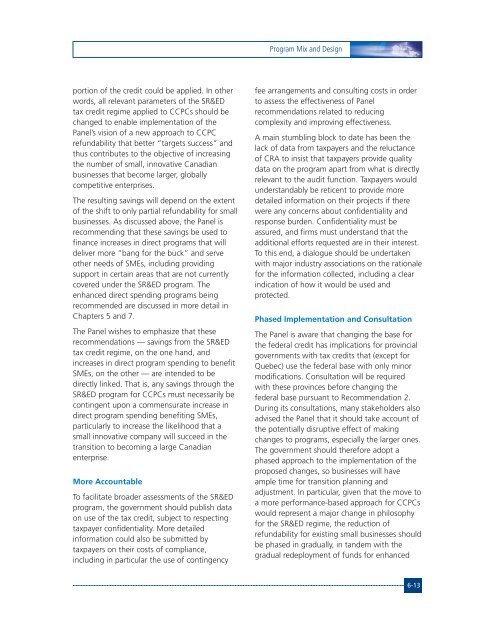Innovation Canada: A Call to Action
Innovation Canada: A Call to Action
Innovation Canada: A Call to Action
You also want an ePaper? Increase the reach of your titles
YUMPU automatically turns print PDFs into web optimized ePapers that Google loves.
Program Mix and Designportion of the credit could be applied. In otherwords, all relevant parameters of the SR&EDtax credit regime applied <strong>to</strong> CCPCs should bechanged <strong>to</strong> enable implementation of thePanel’s vision of a new approach <strong>to</strong> CCPCrefundability that better “targets success” andthus contributes <strong>to</strong> the objective of increasingthe number of small, innovative Canadianbusinesses that become larger, globallycompetitive enterprises.The resulting savings will depend on the exten<strong>to</strong>f the shift <strong>to</strong> only partial refundability for smallbusinesses. As discussed above, the Panel isrecommending that these savings be used <strong>to</strong>finance increases in direct programs that willdeliver more “bang for the buck” and serveother needs of SMEs, including providingsupport in certain areas that are not currentlycovered under the SR&ED program. Theenhanced direct spending programs beingrecommended are discussed in more detail inChapters 5 and 7.The Panel wishes <strong>to</strong> emphasize that theserecommendations — savings from the SR&EDtax credit regime, on the one hand, andincreases in direct program spending <strong>to</strong> benefitSMEs, on the other — are intended <strong>to</strong> bedirectly linked. That is, any savings through theSR&ED program for CCPCs must necessarily becontingent upon a commensurate increase indirect program spending benefiting SMEs,particularly <strong>to</strong> increase the likelihood that asmall innovative company will succeed in thetransition <strong>to</strong> becoming a large Canadianenterprise.More AccountableTo facilitate broader assessments of the SR&EDprogram, the government should publish dataon use of the tax credit, subject <strong>to</strong> respectingtaxpayer confidentiality. More detailedinformation could also be submitted bytaxpayers on their costs of compliance,including in particular the use of contingencyfee arrangements and consulting costs in order<strong>to</strong> assess the effectiveness of Panelrecommendations related <strong>to</strong> reducingcomplexity and improving effectiveness.A main stumbling block <strong>to</strong> date has been thelack of data from taxpayers and the reluctanceof CRA <strong>to</strong> insist that taxpayers provide qualitydata on the program apart from what is directlyrelevant <strong>to</strong> the audit function. Taxpayers wouldunderstandably be reticent <strong>to</strong> provide moredetailed information on their projects if therewere any concerns about confidentiality andresponse burden. Confidentiality must beassured, and firms must understand that theadditional efforts requested are in their interest.To this end, a dialogue should be undertakenwith major industry associations on the rationalefor the information collected, including a clearindication of how it would be used andprotected.Phased Implementation and ConsultationThe Panel is aware that changing the base forthe federal credit has implications for provincialgovernments with tax credits that (except forQuebec) use the federal base with only minormodifications. Consultation will be requiredwith these provinces before changing thefederal base pursuant <strong>to</strong> Recommendation 2.During its consultations, many stakeholders alsoadvised the Panel that it should take account ofthe potentially disruptive effect of makingchanges <strong>to</strong> programs, especially the larger ones.The government should therefore adopt aphased approach <strong>to</strong> the implementation of theproposed changes, so businesses will haveample time for transition planning andadjustment. In particular, given that the move <strong>to</strong>a more performance-based approach for CCPCswould represent a major change in philosophyfor the SR&ED regime, the reduction ofrefundability for existing small businesses shouldbe phased in gradually, in tandem with thegradual redeployment of funds for enhanced6-13
















